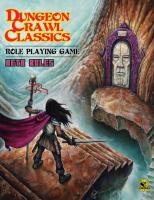Since time immemorial you and your people have toiled in the shadow of the cyclopean ruins. Of mysterious origins and the source of many a superstition, they have always been considered a secret best left unknown by the folk of your hamlet.
But now something stirs beneath the crumbling blocks. Beastmen howl in the night and your fellow villagers are snatched from their beds. With no heroes to defend you, who will rise to stand against the encircling darkness? The secrets of Chaos are yours to unearth, but at what cost to sanity or soul?
An introductory adventure for the Dungeon Crawl Classics Roleplaying Game, Sailors on the Starless Sea pits a mob of 0-level adventurers against the legacy of the Chaos Lords and their corrupted hordes. Delving beneath the crumbling ruins, the characters discover ancient crypts, a starless sea, and an ancient ziggurat, where death and treasure await in equal measure!
So goes the pitch of the first 0-level module for the newly released Dungeon Crawl Classics RPG. I plan to cover three different things in this post: the character creation process, 0-level play, and the module itself.
As my lone player sat the gaming table throwing together a small horde of peasants it became clear: though the character creation rules may not be for everyone, they are by far the most fun of any system we have played. Let me explain. In most other RPGs, the players have a lot of say during character creation. It's pretty much the opposite in DCC RPG. With the exception of your name, everything is left up to the dice. Stats, equipment, occupation—everything else is rolled randomly.
So why is this fun? To start, it's fast. I've run a few 0-level games at this point, and generating ten characters can happen in as many minutes. This is a good thing, as most of these 0-level peasants are going to die in the first adventure. This method also produces some brilliantly insane character concepts. For example, my player rolled an Elven Sage who was incapable of speaking Elven, could not read or write, and whose only possessions were a quill pen and paper.
GMs and/or players might be tempted to skip this process and begin the game at 1st level. In the introduction to Sailors. . . the author does say this adventure would also be a suitable challenge for some 1st level characters plus a few 0-level hirelings. I would strongly recommend against doing that, especially if this is your first experience with DCC RPG or roleplaying in general. One of the strengths of 0-level play is that it's very light on rules. The amount of time wasted paging through the rulebook is non-existent. This allows you and your players to focus on the stuff that matters: the story and your characters' roles in it.
Aside from the preamble on the back and a table of rumors which your players roll on randomly (of course), little is known about the cyclopean ruins. DCC RPG thrives on the unknown, the alien, the strange. None of the creatures in Sailors are reskinned fantasy cliches. More importantly, due to (what else?) some random tables no two playthroughs of this module are going to be exactly the same.
One thing that surprised me is how many encounters and encounter areas there are for this level of play. Counting each obstacle (puzzle, trap, combat), there are a little over ten in total. The final level of the dungeon has some particularly nasty encounters. Resourceful players will have no trouble surviving these as the dungeon gives the players all the tools they need to persevere. Should players leave some parts of the dungeon unexplored they will find themselves considerably less prepared. Should players lose all of their characters, the dungeon also provides opportunity to find some new recruits.
Sailors on the Starless Sea is the perfect introductory adventure for Dungeon Crawl Classics RPG. It's got the right mixture of weirdness to fulfill its promise as the torchbearer of Appendix N fantasy roleplaying and enough charm to woo veterans and newcomers to tabletop gaming alike. It's also a good template for GMs looking to design their own 0-level adventures for this game. If you're still not convinced you should check this out, take one last look at that cover.













